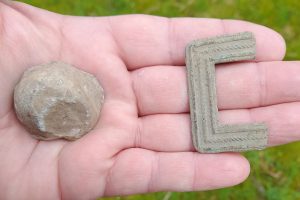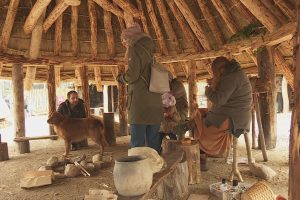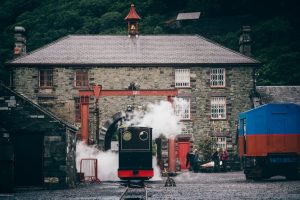Petition calls for more funding for Welsh heritage
With key Welsh heritage bodies, including national museums, facing budget cuts of >10%, a petition has been launched to call for increased funding. Over 11,000 people have signed (petitions.senedd.wales/petitions/246088), meaning it will be considered for debate in the Senedd (pictured).
Clan chief’s buckle found at Culloden?
The National Trust for Scotland has found a shoe buckle at the site of the Battle of Culloden, and has suggested that it may have belonged to clan chief Donald Cameron of Lochiel. Grapeshot was found at the same spot, which tallies with the known cause of his death. [@N_T_S]
Antonine Wall exhibition visits Bo’ness
A temporary exhibition, ‘Antonine Wall: Beyond the Boundaries’, is now open at Kinneil House in Bo’ness – the wall runs near the 16th century house managed by Historic Environment Scotland, and the exhibition explores the Roman influence in central Scotland. [@HistEnvScot]
Scottish Crannog Centre reopens after being destroyed by fire
The Scottish Crannog Centre in Perthshire, a museum of the Iron Age showcasing Pictish culture, has reopened, three years after its replica roundhouses were destroyed by fire. The site features seven buildings built using traditional skills. [@ScottishCrannog]
Pembrokeshire scientist challenges Stonehenge bluestones theory
Archaeologist Mike Parker Pearson’s claim that the bluestones of Stonehenge were originally sited at Waun Mawn in Pembrokeshire, featured in a BBC documentary in 2021, has been challenged by local geoscientist Dr Brian John in a new paper (DOI:10.1177/09596836241236318). [Picture by Dr Brian John]
Bones found on Cornish coast analysed
Two sets of bones found on the Cornish coast last year have now been analysed. One, found on cliffs near Padstow, dates from the 18th century, perhaps a shipwrecked sailor; the other, at Sennen, come from a Bronze Age man, c.1300BC. [Cornwall Archaeological Unit]
Heritage Fund awards £15m to industrial projects
The National Lottery’s Heritage Fund has earmarked £14.8m for projects relating to the history of innovation, transport and industry. They include a redevelopment of the National Slate Museum in Wales (pictured, Amgueddfa Lechi Cymru), Glasgow’s Pipe Factory and Scilly’s Old Town Hall.
Museum marks black community’s contribution to WW2
A new exhibition at Lydiard House Museum near Swindon explores the contribution of black people to the world wars in Wiltshire. Many African American troops were stationed at Lydiard Park during WW2. [Swindon Borough Council]
People’s Palace, Glasgow to close for major revamp
The People’s Palace in Glasgow, showcasing the city’s social history, will close on 14 April for a major refurbishment of the museum and the Winter Gardens glasshouse. A ‘last chance to see’ exhibition is now on; the work is expected to take 16 months. [@glasgowmuseums]
Sculpture to remember Jersey witch trial victims
A new sculpture, ‘Our Hands’, will go on display at Jersey Museum later this year to commemorate the 65 islanders tried for witchcraft (33 of them executed) between 1560 and 1660. The sculpture incorporates casts of 65 volunteers’ hands.
Exciting finds from ‘Peterborough’s Pompeii’
News of archaeological finds at Must Farm near Peterborough continues to break thanks to the work of Cambridge Archaeological Unit, which has published its first books about Britain’s biggest hoard of Bronze Age artefacts – the dig revealed 10 wooden homes, destroyed by fire c.850BC. [@CambridgeUnit]
Stockport Hat Works reopens
Britain’s only museum dedicated to the hat-making industry, the Hat Works Museum in Stockport, has reopened this week after a four-year redevelopment project. Working Victorian machinery can be seen, along with more than 1000 new objects. [@hatworksmuseum]












